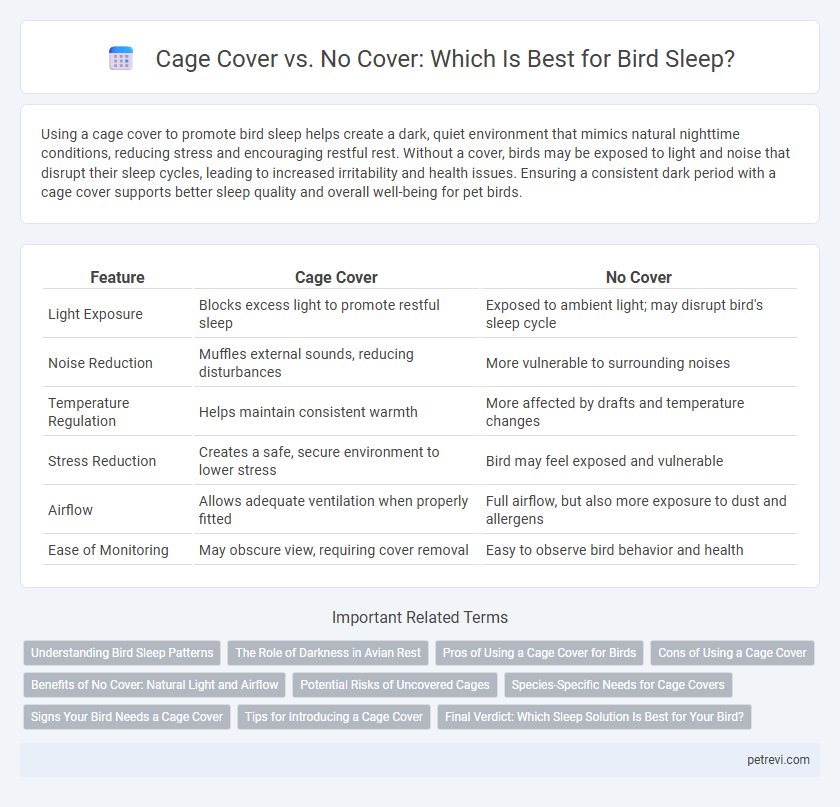Using a cage cover to promote bird sleep helps create a dark, quiet environment that mimics natural nighttime conditions, reducing stress and encouraging restful rest. Without a cover, birds may be exposed to light and noise that disrupt their sleep cycles, leading to increased irritability and health issues. Ensuring a consistent dark period with a cage cover supports better sleep quality and overall well-being for pet birds.
Table of Comparison
| Feature | Cage Cover | No Cover |
|---|---|---|
| Light Exposure | Blocks excess light to promote restful sleep | Exposed to ambient light; may disrupt bird's sleep cycle |
| Noise Reduction | Muffles external sounds, reducing disturbances | More vulnerable to surrounding noises |
| Temperature Regulation | Helps maintain consistent warmth | More affected by drafts and temperature changes |
| Stress Reduction | Creates a safe, secure environment to lower stress | Bird may feel exposed and vulnerable |
| Airflow | Allows adequate ventilation when properly fitted | Full airflow, but also more exposure to dust and allergens |
| Ease of Monitoring | May obscure view, requiring cover removal | Easy to observe bird behavior and health |
Understanding Bird Sleep Patterns
Bird sleep patterns vary significantly, with many species relying on darkness and stillness to enter deep sleep cycles. Using a cage cover can simulate a natural nighttime environment by blocking light and reducing external stimuli, which helps birds feel secure and promotes restful sleep. Without a cover, birds may experience fragmented sleep due to exposure to light and movement, potentially causing stress and impacting their overall health.
The Role of Darkness in Avian Rest
Darkness plays a crucial role in regulating avian circadian rhythms, promoting deeper and more restorative sleep. Using a cage cover helps simulate natural night conditions by blocking out artificial light and visual disturbances, which can reduce stress and improve sleep quality in birds. Without a cover, exposure to ambient light and activity may disrupt melatonin production, leading to fragmented rest and behavioral issues.
Pros of Using a Cage Cover for Birds
Using a cage cover for birds promotes better sleep by reducing light and noise, helping them feel secure and relaxed. It also minimizes drafts and sudden temperature changes that can cause stress or illness. Cage covers create a calm environment that supports natural sleep patterns and overall well-being in pet birds.
Cons of Using a Cage Cover
Using a cage cover for bird sleep can restrict airflow, leading to poor ventilation and increased humidity inside the cage, which may cause respiratory issues. Covering the cage also limits visual stimulation and social interaction, potentially inducing stress and behavioral problems in birds. Moreover, some birds may feel trapped or anxious under the cover, negatively impacting their overall well-being and sleep quality.
Benefits of No Cover: Natural Light and Airflow
Allowing birds to sleep without a cage cover exposes them to natural light, helping regulate their circadian rhythms and promoting healthier sleep cycles. Uncovered cages provide better airflow, reducing the buildup of moisture and harmful airborne particles, which lowers the risk of respiratory problems. This environment mimics a bird's natural habitat, promoting overall well-being and reducing stress.
Potential Risks of Uncovered Cages
Uncovered bird cages during sleep expose birds to drafts, sudden temperature changes, and increased light, which can cause stress and disrupt their natural sleep patterns. Without a cage cover, birds are more vulnerable to external stimuli such as noises and movements, leading to anxiety and sleep deprivation. Prolonged exposure to these risks may weaken the bird's immune system, increasing susceptibility to respiratory infections and other health issues.
Species-Specific Needs for Cage Covers
Cage covers for birds provide darkness and reduce external stimuli, which can be beneficial for species like parrots and cockatiels that require uninterrupted sleep for optimal health. However, some species such as finches and canaries may experience stress or respiratory issues from restricted airflow under covers, highlighting the importance of choosing cage covers based on specific behavioral and environmental needs. Understanding the unique sleep patterns and sensitivity of each bird species ensures that cage covers enhance rest without causing discomfort or health risks.
Signs Your Bird Needs a Cage Cover
Signs your bird needs a cage cover include increased restlessness, excessive vocalization, and difficulty settling down at night. Birds showing frequent waking, fluffed feathers, or apparent stress during sleep hours benefit from a cage cover that creates a dark, quiet environment mimicking natural conditions. Using a cage cover can improve sleep quality and overall well-being by reducing disturbances and providing a secure, calming space.
Tips for Introducing a Cage Cover
Introducing a cage cover can enhance a bird's sleep by reducing light and noise, creating a calm environment that mimics their natural roosting conditions. Gradually acclimate your bird by first draping the cover partially during sleep time, observing their comfort level before fully covering the cage overnight. Select breathable, lightweight fabric to maintain proper airflow while ensuring the bird feels secure and stress-free.
Final Verdict: Which Sleep Solution Is Best for Your Bird?
Choosing between a cage cover and no cover for bird sleep depends on the specific bird species, environmental conditions, and individual behavior patterns. Cage covers can mimic natural darkness, reduce external stimuli, and provide a sense of security, which is beneficial for many birds to achieve restful sleep. Conversely, some birds prefer an uncovered cage for adequate ventilation and freedom, making observation easier, so assess your bird's comfort and health to determine the optimal sleep solution.
Cage cover vs No cover for Bird sleep Infographic

 petrevi.com
petrevi.com